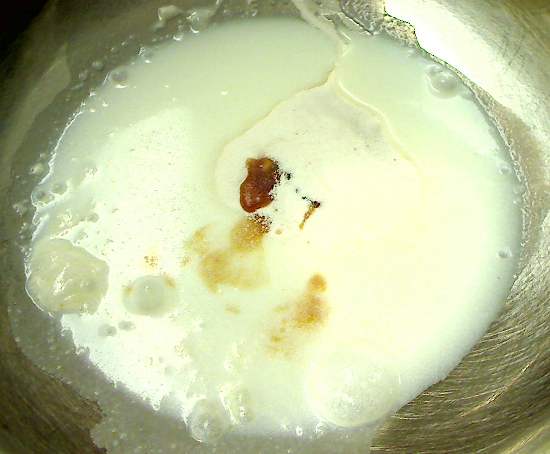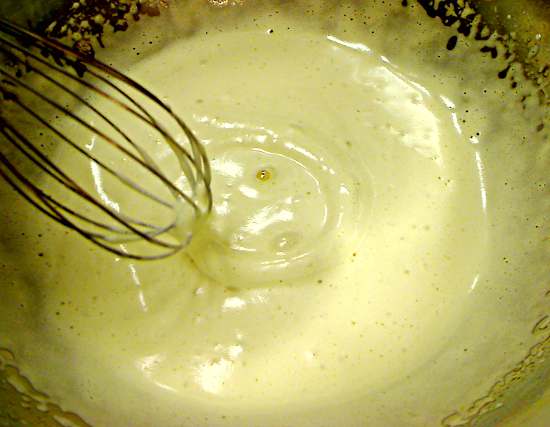
- You've gotta have heart
All you really need is heart
When the odds are saying you'll never win
That's when the grin should start
- Jerry Ross, Richard Adler - Damn Yankees
Revised: Feb. 7, 2011
The original Gotta-Have-Heart cake was a simple chocolate genoise, inspired by news of chocolate as a health food. When I was ready to replace the low-res pictures in that recipe with new ones, a new inspiration beckoned me to a different direction: creme-filled gobs (a.k.a. whoopie pies). Because the cake slices are so thin (1/4 inch), they're really more like skinny cake sandwiches than the average gob or whoopie and better served on a plate than held in the hand, a more formal pastry. The basic chocolate genoise has been decked with Mexican-style flavorings: hot spices and ground almonds and a sturdier crumb, but has retained the moisturizing grape syrup drench. The upscale filling combines the earthy caramel of a dulce de leche spread with a heap of light, lemon-scented lavender creme.
Every year, there are countless news items extolling the health benefits of chocolate. At the time of the original Gotta-Have-Heart cake, headlines were proclaiming that chocolate eaters had a lower risk of heart attacks and possessed radiant skin with fewer wrinkles and that pairing chocolate with wine could protect against stroke. Hence, I mixed up mini chocolate heart cakes infused with Concord grape syrup to celebrate this cascade of cocoa-related revelations (Concord grapes being packed with resveratrol, a compound famous for its potential anti-aging properties and a synergistic combination with chocolate). Those were the original Gotta-Have-Heart cakes.
Last year, I came across an article in the San Francisco Chronicle about an east coast snack cake sweeping into west coast markets and eateries: the whoopie pie or gob. Gobs were now sold all over the Bay Area. They were a publishing sensation too. I counted no less than 6 cookbooks dedicated to the whoopie pie on Amazon.com and all published (or to be published) between 2009 and 2011. Gobs had become a culinary trend in America. So, when I began updating the Gotta-Have-Heart recipe for a new photo shoot, I pulled out the old mixing bowl and went to work on my own version of gobs.
The classic gob is better classified as a cake sandwich than a cookie sandwich, although over the years, the distinction has not been scrupulously observed. The cake itself is typically a sponge cake, charged with a reliable chemical leavener. A genoise cake in this recipe employs no chemical leavener, but relies on an intensely-beaten egg foam to lighten it. Because my only mixing device is an electric whisk (and not the fastest whisk at that), beating alone at room temperature will not fully saturate the egg foam with air. A method for making an acceptable electric-whisk egg foam was detailed in my apple madeleines recipe. It involved heating the batter twice to over 100°F/38°C.
In this recipe, maximum lift isn't necessary. Plus, the extra ingredients for Mexican-style chocolate genoise collapse the egg foam anyway, leaving a fraction of the suffused air behind. That tiny amount of air still tenderizes the cake, so the egg foam can't be avoided. To save time, I only partially whip the egg foam. However, for those with more powerful mixers than I have, I recommend beating a fully-saturated egg foam, because it will produce a more tender cake. Just continue beating on high speed in step 5 until a dripped ribbon stays visible for 15 seconds or longer.
Espresso powder appears to be the preferred ingredient for enhancing chocolate, but I used what I had on hand. The coffee bean powder very effectively punches up the cocoa flavor to match the cake's deep intensity color. It's nothing more than supermarket ground coffee (Folgers medium roast in this instance) that has been pulverized in a coffee grinder. The coffee powder must be very fine ground, or the cake will end up gritty. This is an important flavoring to ramp up the intensity of the chocolate. For substitutes, I'd try instant coffee powder or a coffee extract.
The cakes are baked in a falling oven (20 minutes at 270°F and 20 minutes at 250°F) so that the batter heats up faster and the air bubbles can expand more before it sets - but not to leaven. The purpose of the higher start temperature is to tenderize the cakes with a finer crumb. At no point should the cakes actually get hotter than 250°F/121°C, as the batter's still not quite set when the oven temperature begins falling. Alternatively, they could be baked in a steady oven at 250°F/121°C for 50 to 60 minutes as originally specified, especially if the egg foam had been whipped to maximum aeration. Otherwise, a dash (1/4 teaspoon) of baking powder in the batter could also help tenderize the cakes.
When made in the specified pans, the cakes are about 1/2 inch thick, essentially the height of the batter before baking. Initially, I worried the cakes might be difficult to slice horizontally. However, the firm texture withstood thin slicing, and I was always able to do it without it tearing or crumbling, due in no small part to a sharp, finely serrated knife.
Historically, the creamy filling for a gob was a kind of marshmallow creme or a shortening-based frosting. In this recipe, the cakes are filled with prepared Dream Whip whipped topping mix, scented and tinted with lemon and lavender. At 140 calories per cup, it's half as calorie dense as plain marshmallow creme. A meringue frosting, such as 7-minute frosting, made with fresh lemon zest and lavender powder, would be a good substitute for either Dream Whip or marshmallow creme.
The lemon zest and milk for the Dream Whip topping has to infuse for several hours in the refrigerator. I considered warming the milk first to accelerate the infusion, but heating would have changed the taste and the texture of milk and possibly the fluff of the topping. The recipe specifies 1/4 to 1/2 teaspoon of lemon zest for the infusion. With the 1/4 teaspoon amount, the zest brightens the taste of the lavender creme and subtly scents it with lemony freshness - very delicious as it is. The optional 1/2 teaspoon of zest is for those who want a stronger lemon flavor. Lavender has been a mainstay flavoring of artisanal chocolates. I make the lavender sugar by fine-grinding dried culinary lavender flowers and granulated white sugar in a 2-to-1 ratio by volume. The sugar assists the spice grinder by adding heft to blossoms.
Makes 2 gobs (each gob can serve one or two)
- 190 calories per gob
- Oven temperature: 250°F/121°C
Cake
- 3 tablespoons all-purpose flour
- 1 tablespoon dark cocoa powder
- 1 teaspoon almond flour
- 1/2 teaspoon cornstarch
- 1/4 teaspoon cinnamon
- 1/8 teaspoon coffee bean powder, very fine ground (see text)
- 1/8 teaspoon chili powder
- pinch of salt
- 1 large egg
- 1/8 cup granulated sugar
- 1-1/2 teaspoon dark agave syrup or dark maple syrup (grade A)
- 1/8 teaspoon vanilla extract
- 1/8 teaspoon almond extract
- 2 teaspoons butter
- 1 teaspoon olive oil
- 1 tablespoon raisin puree (see below, see text)
- 1 teaspoon Concord grape jam
- 2 teaspoons water
- 1 cup lavender creme filling
- 2 tablespoons dulce de leche (optional)
- 1 tablespoon raisins
- 3 tablespoons boiling water
- 1/2 package Dream Whip (about 2 tablespoons)
- 1/4 cup cold milk
- 1/4 to 1/2 teaspoon grated lemon zest (dried or fresh - see text)
- 1/4 teaspoon vanilla extract
- 1 teaspoon lavender sugar (see below)
- 1/8 cup confectioner's sugar
- 1 teaspoon lavender sugar (see below, see text)
- fresh grated lemon zest (optional)
- 1 tablespoon sugar
- 2 tablespoons dried lavender flowers
Raisin Puree Method:

1. Soak raisins in boiling water.

2. Puree the mixture with an immersion blender or in a mini food processor.
Concord Syrup Method:

1. In a small microwave-safe bowl, mix grape jam and water. Heat in microwave until the mixture simmers (about 1 minute).

Lemon-Lavender Creme Method:

1. In a small bowl, mix the milk and lemon zest. Cover and infuse in the refrigerator for 5 to 6 hours or overnight.

2. Strain the milk. Press the lemon zest against the strainer to extract any remaining liquid and discard the zest. If necessary, add more milk to bring volume back up to 1/4 cup.

3. Refrigerate the lemon-milk until ready to use.

4. Prepare 1/2 of an envelope of Dream Whip (about 2 tablespoons of mix) according to the package instructions with the lemon-milk and 1/4 teaspoon of vanilla extract.

5. Mix in the lavender powder.

6. Cover and refrigerate until ready to use.
Gob Cake Method:

1. Thoroughly mix together the flour, cocoa powder and cornstarch in a small bowl and set aside. If available, cake flour can be substituted for the all-purpose flour and cornstarch.

2. Melt the butter in a small heatproof dish in the microwave. Mix in the olive oil and raisin puree. Set aside.

3. Put the egg, sugar, vanilla extract, almond extract, agave syrup and salt in a heatproof bowl and whisk until frothy.
4. Bring a saucepan with 1 inch of water to a simmer and place the bowl over the saucepan. Monitor the temperature of the mixture with an instant-read thermometer (preferably a digital instant read). Stir the mixture until it reaches a temperature of 105°F/41°C. Heating the mixture will help it hold more air when it’s whipped.

5. Remove the bowl from the saucepan and whip the egg mixture with an electric whisk or mixer on HIGH speed until the batter turns a pale yellow and the volume triples. When dripped from the beater, the batter should trail a ribbon that stays visible for about 5 to 6 seconds (about 4 or 5 minutes of beating, depending on the speed of the mixer).
For those with a strong handheld mixer or a stand mixer, I recommend beating the egg foam until the dripped ribbon stays visible for over 15 seconds.

6. Sift a small portion of the flour mixture over the batter and fold in with a spatula or large soup spoon.

7. Drip a portion of the butter-oil-raisin mixture along the edge of the batter where it meets the bowl and fold it into the batter.

9. Repeat steps 7 and 8 until both mixtures are completely incorporated.

10. Grease two mini heart molds (5/8 cup capacity) and spoon batter into molds. The molds should be at least half full.

11. Bake for 20 minutes at 270°F/132°C. Then reduce the heat to 250°F/121°C and bake for another 20 minutes. (Alternatively, bake in a steady oven at 250°F/121°C for 50 to 60 minutes - see text.) Test for doneness by inserting a toothpick or wood skewer into the center of a cake. It should come out clean, excluding any surface moisture.

12. Cool and unmold. Place on rack to allow any excess moisture on the bottom and sides to evaporate.

13. Each cake should be about 1/2 inch thick. Thinner cakes will be harder to slice.

14. Slice each heart cake horizontally and brush the inside surfaces with the grape syrup. Avoid brushing on too much syrup or the cake will be soggy.

15. Spread one side with lavender creme and the other side with (optional) dulce de leche milk-caramel spread. Dulce de leche may be softened in the microwave for easier spreading.

16. Reassemble the cake halves. Dust the top of each gob with a mixture of confectioner's sugar and lavender powder. If desired, sprinkle on fresh grated lemon zest.


No comments:
Post a Comment